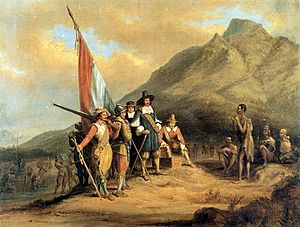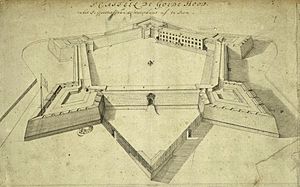History of the Cape Colony before 1806 facts for kids
The history of the Cape Colony in what is now South Africa began a long time ago. It started when a Portuguese explorer named Bartolomeu Dias sailed around the Cape of Good Hope in 1488. This was the first time a modern European ship had done this! Later, in 1497, another explorer, Vasco da Gama, sailed all along the coast of South Africa. He stopped at St Helena Bay for eight days on his way to India.
The Portuguese explorers were very interested in the riches of Asia. Because of this, they didn't build any lasting settlements at the Cape. However, the Dutch East India Company (VOC) saw the area as a perfect spot. It was a great place for their ships to stop, get fresh water, and restock their food supplies.
Contents
First European Settlement at the Cape
- Further information: Dutch Cape Colony

The Dutch East India Company started its settlement in the Cape in March 1647. This happened after a Dutch ship, the Nieuwe Haarlem, was shipwrecked there. The sailors who survived built a small fort. They called it the "Sand Fort of the Cape of Good Hope." They stayed for almost a year until other ships rescued them.
After returning to Holland, some of these shipwrecked sailors suggested an idea. They tried to convince the Dutch East India Company to build a trading post at the Cape.
In 1652, a group of 90 Calvinist settlers arrived. They were led by Jan van Riebeeck. He had been on one of the rescue ships and saw how good the land was. They started the first permanent settlement near the Cape of Good Hope. They arrived in the harbour of modern-day Cape Town on April 6, 1652. They came with five ships:
- Reijger
- Oliphant
- Goede Hoop
- Walvisch
- Dromedaris
The first settlers built a fort using clay and wood. Later, between 1666 and 1679, they replaced it with the Castle of Good Hope. This castle is now the oldest building in South Africa! The colony truly began to grow in 1671. That's when the settlers bought land from the Khoikhoi people. This land was beyond the first fort's original boundaries.
The Dutch East India Company wanted to keep the colony small. They hoped to have only a few workers grow food near the fort. They also planned to get cattle from the local Khoikhoi people. But their crops often failed. So, the company allowed some workers to become independent farmers. These farmers would grow food on their own land. More land was given out when Simon van der Stel became the new commander in 1679.
Van der Stel encouraged more farming and growth. His son, William, continued this policy. By 1705, there were 258 farms in the colony. By 1731, this number almost doubled to 435 farms. However, wealth was not shared equally. By 1731, a small number of settlers owned more than half of all private property.
Most early colonists were working-class people. They weren't very interested in developing the colony. But in 1685, a special official was sent to attract more settlers. After that, more dedicated immigrants began to arrive. French refugees came to the Cape after leaving their country. They left because of new laws against their religion. This small group of immigrants had a big impact on the Dutch settlers.
The Dutch East India Company had a rule from 1701. It said that schools should only teach in Dutch. Also, there were strict laws about public gatherings. Because of this, the Huguenots (French refugees) lost their distinct identity. By the mid-1700s, the French language disappeared. By the late 1700s, the Cape Colony was one of the most developed European settlements outside Europe or the Americas.
Economy of the Cape Colony
The Cape Colony's economy relied on two main things: shipping and farming. Its location was very important. Before the Suez Canal opened in 1869, almost every ship sailing between Europe and Asia stopped at Cape Town. These ships needed fresh food, fruit, and wine. Providing these supplies created a very large market for the colony's farmers.
How the Colony Expanded
The colonists slowly took over land from the Khoikhoi people. This land was to the north and east of their base in Cape Town. Many Khoikhoi died in wars. Also, terrible smallpox diseases in 1713 and 1755 greatly harmed whole Khoikhoi tribes. A few tribes managed to stay independent. But most Khoikhoi worked for the colonists as herdsmen.
In 1787, the Dutch East India Company made a law. It placed certain rules on the remaining nomadic Khoikhoi. This law made the Khoikhoi even more dependent on the farmers. Or, it forced them to move north, beyond the colony's border. Those who moved north faced problems with their old enemies, the San. The San lived in the plains from the Nieuwveld and Sneeuwberg mountains to the Orange River.
Conflicts with the Dutch East India Company
The colonists faced challenges from local people and from farming in tough areas. But the strict and unfair rules of the Dutch East India Company caused the most problems. The Company stopped people from moving freely into the colony. It controlled all trade. It also held all the power for administration, making laws, and judging cases. The Company told farmers what crops to grow. It demanded a large part of every farmer's harvest and made their lives difficult.
These rules stopped new businesses and growth. This led to a strong dislike of strict government among the Dutch farmers, known as "boers." They wanted more freedom. To escape the Company's control, the farmers moved farther and farther from the government's center. To try and control these moving farmers, the Company set up new offices. One was in Swellendam in 1745, and another in Graaff Reinet in 1786.
The government said the Gamtoos River was the eastern border. But the farmers soon crossed it. To avoid fighting with the Bantu tribes moving south and west, the Dutch agreed in 1780 to make the Great Fish River the colony's boundary. In 1795, the farmers in the border areas were heavily taxed. They also didn't get protection against the African tribes. So, they kicked out the Company officials. They set up their own independent governments in Swellendam and Graaff-Reinet.
In 1795, the Netherlands was taken over by the French Army led by Napoleon Bonaparte. The Dutch East India Company was weak. So, a British force, led by Sir James Henry Craig, sailed to Cape Town. Their goal was to secure the colony for the Dutch leader, Prince William V of Orange, against the French. The governor of Cape Town first refused to follow the prince's orders. But after Craig threatened to use force, he gave in.
The farmers of Graaff Reinet didn't surrender until an army was sent against them. They also rebelled in 1799 and again in 1801. In February 1803, because of a peace agreement called the Peace of Amiens, the colony came under the control of the Batavian Republic.
See also
- History and timeline of Cape Town
- History of South African wine



